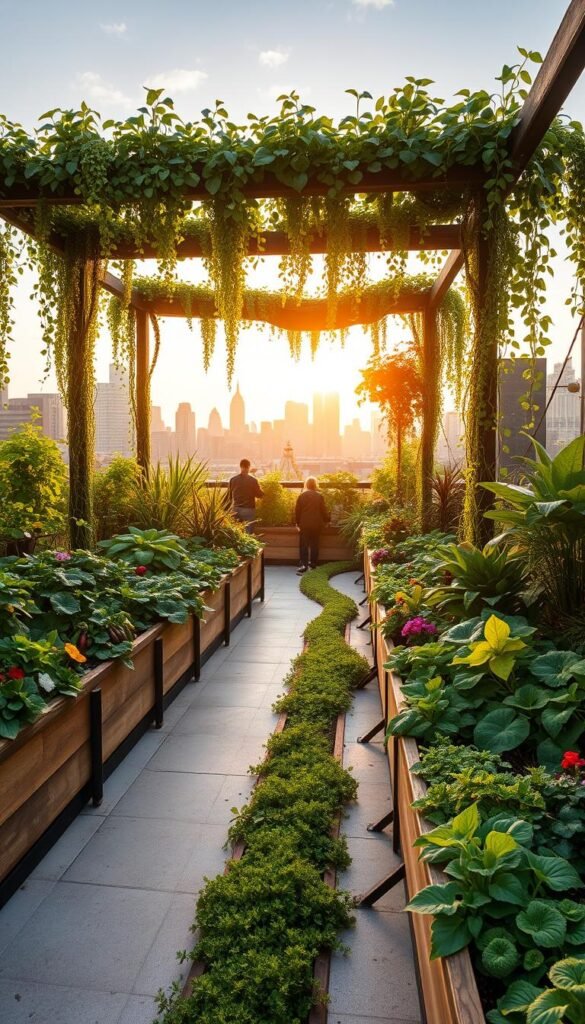Imagine plucking fresh tomatoes from a rooftop planter or harvesting herbs on your apartment balcony. Across the U.S., creative green spaces are reshaping how people access nutritious meals. From Detroit’s 1,400+ community plots to New York’s sky-high farms, city dwellers are rewriting the rules of modern agriculture.
Did you know neighborhoods with these green hubs can be up to 10°F cooler? These initiatives do more than fill plates—they combat heat islands and absorb carbon. Transforming concrete spaces into green oases isn’t just trendy—it’s becoming essential for sustainable living.
You’ll discover how empty parking lots become pumpkin patches and how hydroponic systems thrive in old warehouses. Whether you’ve got a windowsill or a shared backyard, anyone can grow ingredients that travel feet—not miles—to their table.
This movement isn’t just about food. It’s about neighbors bonding over basil plants and kids learning where carrots come from. Cities now see these projects as key tools for tackling hunger gaps and climate challenges simultaneously.
Ready to dig into the details? Let’s explore how innovative growing methods and community teamwork are making concrete jungles bloom with life—and lunch.
Exploring the World of Urban Agriculture
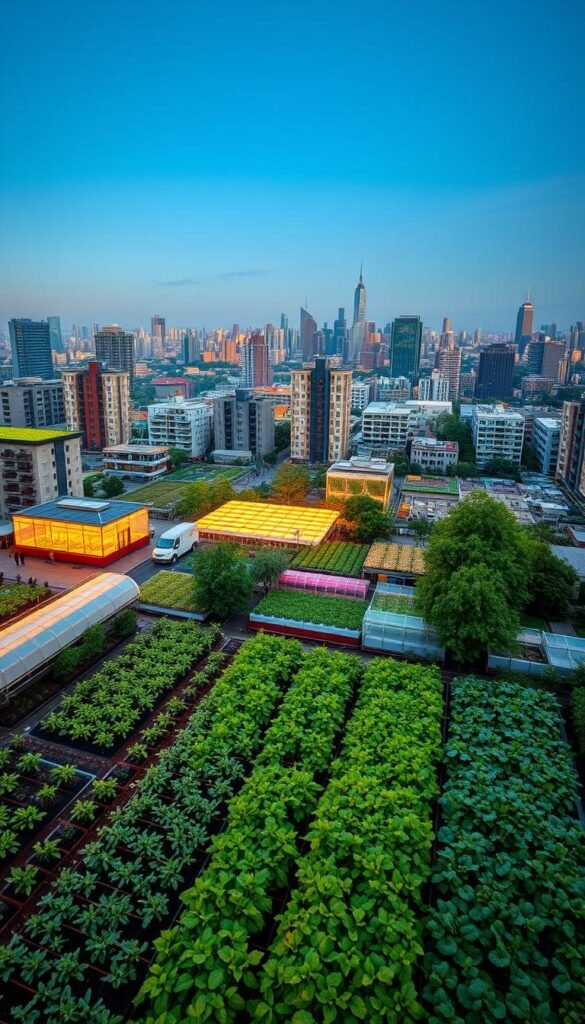
Think beyond the farmer’s market—your next salad could come from a vacant lot down the street. This is the reality of modern urban agriculture, where empty spaces become sources of fresh ingredients. Let’s unpack how this movement works and why it matters to you.
What Urban Farming Means to You
You might encounter two main approaches. Community gardens let neighbors share tools and knowledge while growing herbs or tomatoes together. These spaces often mix vegetable beds with flowering plants, creating pockets of biodiversity.
Then there are professional operations—businesses turning rooftops or warehouses into productive land. They prove you don’t need endless fields to run a successful farm. Many supply local restaurants or CSA programs, shortening the journey from soil to plate.
Historical Shifts in City-Based Food Production
While rooftop beehives feel trendy, growing food in populated areas isn’t new. During WWII, Victory Gardens produced 40% of America’s fresh vegetables. Today’s version addresses climate concerns and food access gaps.
Modern methods blend old wisdom with new tech. Hydroponic systems now grow greens vertically in repurposed buildings. What hasn’t changed? The human desire to connect with our sustenance—and each other—through shared cultivation efforts.
Urban Vegetable Garden Projects: Growing Food in City Environments
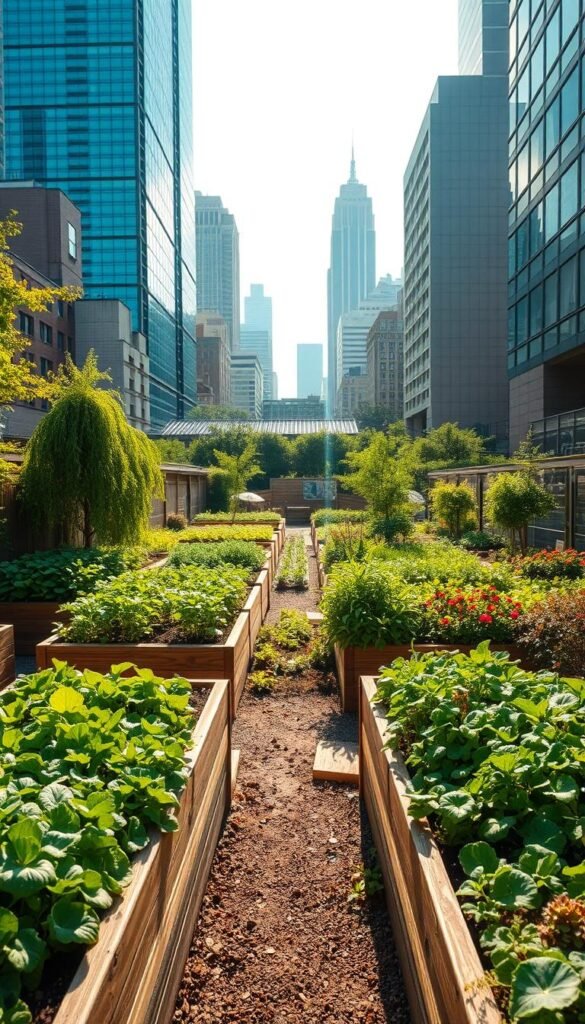
Your next meal could sprout from the most unexpected places. Abandoned parking garages now host rows of oyster mushrooms thriving in recycled coffee grounds. Rooftops once baked by sunlight grow heirloom tomatoes in self-watering planters. These agricultural initiatives prove empty spaces hold untapped potential.
Start by scanning your surroundings with fresh eyes. That fire escape? Perfect for trailing nasturtiums. The south-facing office window? Ideal for dwarf citrus trees. Even cracked sidewalks can support raised beds of rainbow chard. “We’re not just planting seeds—we’re reimagining infrastructure,” notes a Brooklyn-based grower.
Successful projects adapt to their environments. Ground-level plots might use companion planting to deter pests naturally. Rooftop setups often employ lightweight soil mixes and windbreaks. Indoor operations leverage LED grow lights for year-round harvests of basil and microgreens.
Communities are scaling these efforts creatively. Detroit’s Recovery Park Farms transformed 60 vacant acres into a commercial hub supplying local markets. Smaller collectives share tools through neighborhood libraries—from soil test kits to trellis systems. Whether nurturing a windowsill herb cluster or coordinating a block-wide pea patch, every effort counts.
These green revolutions do face challenges. Soil testing becomes crucial in former industrial zones. Zoning laws sometimes clash with composting setups. Yet pioneers keep finding solutions, like Boston’s rooftop apiaries that pollinate crops while producing honey.
Innovative Techniques and Systems for City Farming
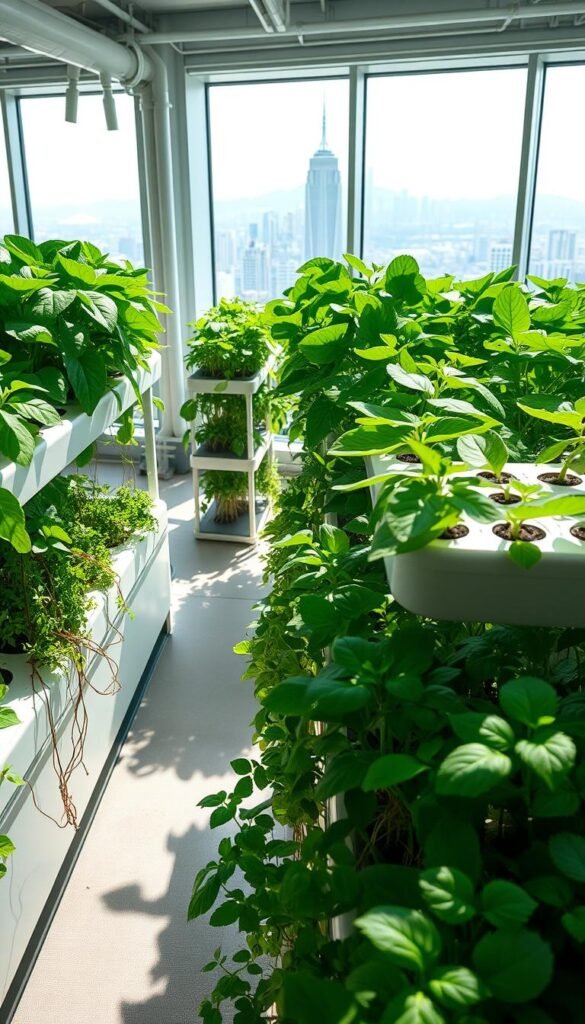
Your kitchen herbs could thrive without a speck of dirt—welcome to modern cultivation breakthroughs. Advanced farming systems let you grow vibrant crops in apartments, basements, or unused vertical surfaces. These approaches solve space constraints while conserving resources.
Hydroponics, Aquaponics, and Soil-Free Methods
Ditch the dirt with nutrient-packed water solutions that feed roots directly. Hydroponic setups use 90% less water than traditional plots. Lettuce and basil flourish in floating rafts or vertical towers, perfect for tight corners.
Combine fish tanks with plant beds for a self-sustaining loop. “Our tilapia feed the kale, and the kale filters their water—it’s a win-win,” explains a Chicago aquaponics enthusiast. This dual-output system yields fresh greens and protein simultaneously.
Vertical Gardening and Rooftop Farming Strategies
Turn blank walls into edible mosaics using pocket planters or modular grids. Strawberries cascade downward while climbing beans reach for sunlight. Rooftops become powerhouses with lightweight soil blends and wind-resistant trellises.
Smart tech elevates these production methods. Automated irrigation detects dry soil, and LED arrays mimic perfect daylight cycles. Brooklyn’s Eagle Street Rooftop Farm proves tomatoes thrive 6 stories up—with skyline views as a bonus.
Choose systems matching your space and goals. Compact hydroponic kits fit on countertops, while community rooftops can host shared compost hubs. Every choice moves us toward greener, tastier neighborhoods.
Realizing the Benefits of Urban Farming
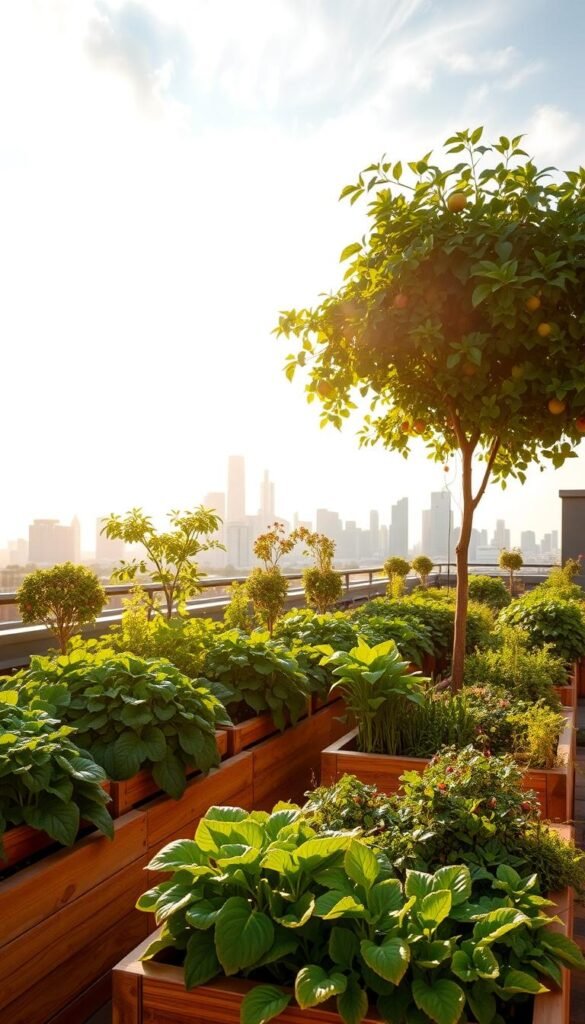
Your daily choices at the planter box ripple far beyond fresh salads. These green spaces offer layered rewards—cooler streets, stronger bonds between apartment dwellers, and tomatoes with smaller carbon footprints than some supermarket varieties. Let’s unpack how tending basil on fire escapes or sharing compost bins transforms concrete landscapes.
Environmental Advantages and Reduced Emissions
While a University of Michigan study found urban plots average higher emissions per serving, smart practices flip the script. Open-air tomatoes beat commercial greenhouse-grown ones in carbon efficiency. Three strategies make the difference: reusing materials (like turning pallets into raised beds), feeding plants with local food scraps, and prioritizing crops with social value.
Extend your garden’s lifespan by choosing durable containers or repurposing old shelves. One Detroit collective cut waste by 60% using donated rainwater barrels and broken concrete for pathways. Every reused item shrinks your plot’s environmental shadow.
Community, Health, and Economic Impacts
Shared growing spaces become neighborhood hubs. A Philadelphia survey found 83% of participants gained new friends through gardening clubs. Digging soil together breaks down barriers—literally and socially. “We’ve turned an old parking lot into a place where kids learn math through measuring squash growth,” shares a teacher involved in youth-focused growing programs.
Health improvements shine brightest. Regular gardeners report 30% less stress and eat 40% more greens weekly. Economic perks range from selling extra kale at pop-up markets to cutting grocery bills by $600/year for dedicated growers. In food deserts, these plots become lifelines—fresh produce steps away, not miles.
Designing Your Ideal Urban Garden Space
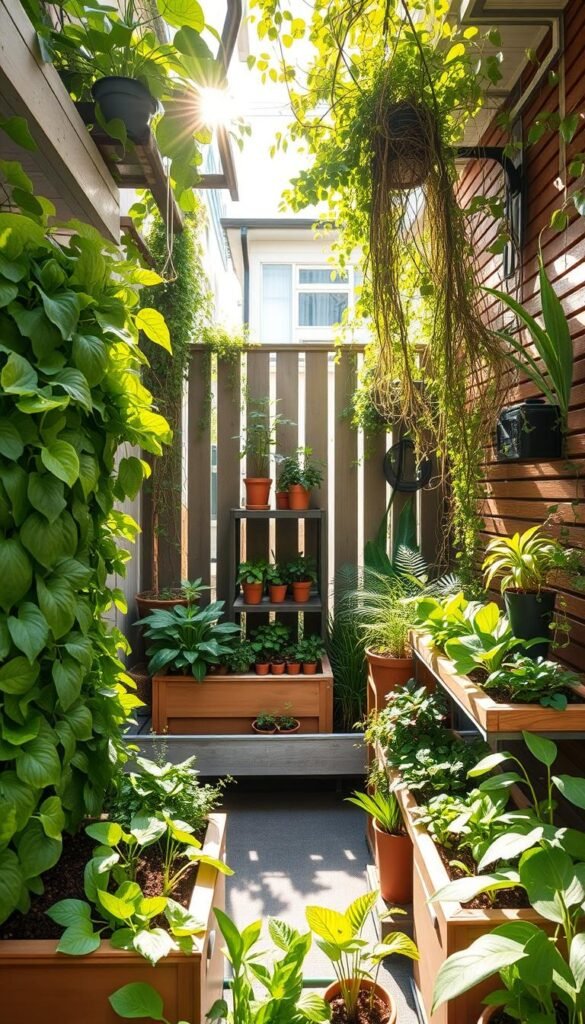
Your balcony railings could become a vertical strawberry farm with pocket planters. Every inch counts when creating green havens in tight spots. Let’s explore how to turn limitations into lush, edible landscapes.
Maximizing Small Spaces and Unused Plots
Start by thinking upward. Hanging baskets for cherry tomatoes or wall-mounted herb grids triple your planting area. Test soil quality before using ground-level plots—many urban farmers switch to raised beds filled with clean soil if contamination risks exist.
Join community growing spaces to access shared tools and knowledge. One Brooklyn group transformed alley dumpsters into mobile lettuce stations. Their secret? Lightweight containers and wheels for chasing sunlight.
Selecting Crops, Fertilizers, and Sustainable Practices
Begin with fast-growing plants like basil and spinach. These thrive in containers and handle variable light. Mix coffee grounds into soil for natural nitrogen boosts—it’s free and reduces kitchen waste.
Try companion planting: marigolds deter pests from pepper crops, while climbing beans shade delicate greens. One Chicago gardener increased yields by 40% using this method. “Healthy soil means happy plants,” she notes, showing off her compost-made fertilizer.
A New Era for Urban Farming: Embrace the Change
The future of fresh produce might just bloom outside your window. From Atlanta’s network of 150+ community plots to Tokyo’s glowing vertical towers, cities are redefining what’s possible. Imagine neighborhoods where every balcony bursts with basil and vacant lots transform into thriving tomato patches.
Oosterwold, Netherlands, proves radical change works. Their mandate for residents to cultivate 50% of their land creates edible landscapes woven into daily life. Meanwhile, tech-driven farms use AI to perfect lettuce growth under LED suns—harvesting greens 365 days a year.
This shift creates opportunities you can taste. Local entrepreneurs supply restaurants with hyper-fresh microgreens, while “pick-your-own” rooftops become weekend destinations. Policy changes help too—zoning updates let apartment dwellers keep hens, and tax breaks support compost hubs.
Your role? Start small with herb pots or join a shared plot. Advocate for school gardening programs or shop at markets supporting urban agriculture. Every seed planted strengthens communities while greening concrete spaces.
As sunlight filters through hydroponic kale or neighbors trade zucchini recipes, one truth emerges: nourishing sustainability grows best when rooted in collective action. The harvest ahead looks brighter—and far more flavorful.
